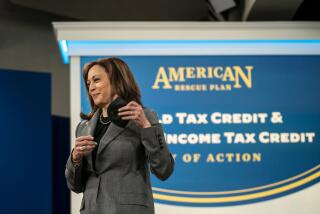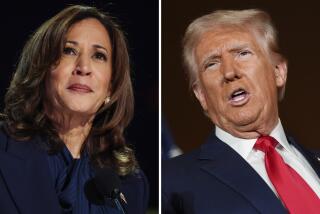Clinton Lays Out Ambitious Plans in Last State of Union
WASHINGTON — Bill Clinton, in the final State of the Union address of his roller-coaster presidency, outlined a far-reaching agenda Thursday that calls for $350 billion in tax cuts and major new investments in education, from preschool to graduate school.
Aiming to force history to look beyond his impeachment to his stewardship of unprecedented prosperity, Clinton said that today’s overflowing treasury could wipe out the 150-year-old national debt in just 13 years--with enough left over to extend the life of Social Security until 2050 and Medicare until 2025.
Detailing an ambitious list of proposals more typical of a first-year president than a lame duck, Clinton challenged the Republican Congress to put substantive accomplishment ahead of the quest for political advantage in this year’s elections.
“We stand on the mountaintop of a new millennium,” Clinton said. “We should be filled with gratitude and humility for our prosperity and progress, with awe and joy at what lies ahead--and with absolute determination to make the most of it.”
Clinton’s delivery was upbeat and confident, even as the speech went on for nearly 90 minutes. Many of his proposals had a distinctly Democratic stamp--from a federal law forbidding job discrimination on the basis of sexual orientation to stricter control on sales at gun shows, which failed to pass last year.
He did not shy from needling Congress. “You can’t gain ground if you’re standing still,” he said. “For too long, this Congress has been standing still on some of our most pressing national priorities.”
With Vice President Al Gore leading the applause, Democrats rose in unison to cheer Clinton’s calls for a patient’s bill of rights, stricter gun laws, campaign finance reform and an increase in the minimum wage. Republicans on the other side of the aisle did not join them.
The GOP side of the chamber already showed more empty seats than usual when Clinton began his address, and after the first hour Republicans started quietly slipping out during standing ovations. By the time the address was over, almost one-third of the Republican section was empty.
Both parties, however, see possibilities for new legislation on tax cuts, education and health care, although perhaps not on the grand scale envisaged by Clinton.
“If we enacted all the new programs the president has talked about, we’d spend just about the entire surplus on bigger and more expensive government,” said House Speaker J. Dennis Hastert (R-Ill.). Yet Hastert, in principle, is a supporter of a Clinton proposal to bring growth to areas left behind by the nation’s economic boom.
No Scandal to Mar Address
Thursday’s speech marked the first time in three years that scandal has not overshadowed the State of the Union. Clinton gave his 1998 message barely a week after the news broke of his sexual liaison with White House intern Monica S. Lewinsky. And as he spoke last year, the Senate was trying charges brought by the House in his impeachment.
To watch Clinton on Thursday night, it would seem--incredibly--as if none of that had ever happened. Recognizing First Lady Hillary Rodham Clinton’s advocacy on behalf of children, he gazed up at her in the galleries and silently mouthed: “I love you.”
Lawmakers from both parties applauded when Clinton asserted that Congress must “draw the line here” against attacks on blacks and other minority groups, but Republicans sat with their hands folded when he asked the two houses to support his hate crime legislation.
The biggest applause of the evening went to former Atlanta Brave and home-run king Hank Aaron.
The nine Supreme Court justices did not show this year, ostensibly because of travel commitments. Nonplused, congressional leaders moved the members of the Joint Chiefs of Staff into the front-row space usually reserved for the justices.
Republicans reacted with skepticism at Clinton’s proposals and some discomfort at his mastery of the political stage.
Rep. Howard P. “Buck” McKeon (R-Santa Clarita) bristled at Clinton’s efforts to claim credit for prosperity. “It was not until Republicans took over Congress in 1995 that we began the era of balanced budgets, economic recovery, welfare reform and saving Social Security,” the California congressman said.
But Clinton seemed determined to wrest some significant accomplishments from his last year in office. Some of his key proposals seemed crafted to appeal to Republicans.
On the tax front, his plan to reduce the so-called marriage penalty for two-earner married couples responds to GOP concerns.
Clinton also called for tax breaks to encourage charitable contributions by the middle class and the wealthy alike, a goal long advocated by social conservatives.
A Long List of Education Initiatives
Clinton’s tax cut package is projected to cost $350 billion over 10 years, but $100 billion in “loophole closing” tax increases to be detailed in his Feb. 7 budget will reduce the net tax cut to $250 billion.
Sounding at times like the chairman of a national school board, Clinton pitched a flurry of education proposals.
The initiatives include a $1-billion increase in the Head Start program for disadvantaged preschoolers, more than $500 million to expand after-school programs of growing importance to two-earner and single-parent families, another $1 billion in grants to help states and communities hire more teachers and a $30-billion package of tax breaks for college education.
The college tax break would allow families to deduct up to $10,000 in college expenses, for a tax savings of up to $2,800 a year.
Clinton also pledged to include in his budget a plan to narrow what he called the digital divide between rich and poor in Internet access.
Seeing vindication in today’s strong economy, Clinton argued that prosperity makes possible a more activist government. “In 1992 we just had a road map. Today we have results,” he said.
First elected when deficits loomed as far into the future as economists could peer, Clinton proudly reeled off a string of upbeat indicators: “We begin the new century with over 20 million new jobs, the fastest economic growth in more than 30 years, the lowest poverty rates in 20 years, the lowest African American and Hispanic unemployment rates on record, the first back-to-back budget surpluses in 42 years.
“Next month, America will achieve the longest period of economic growth in our entire history. We have built a new economy.”
He warned against Republican plans for a much larger tax cut that would divert money from the White House aim of paying down the national debt.
Striking a tone of law-and-order at a time when the public has been shocked by crimes involving guns, Clinton urged states to require handgun buyers to obtain licenses that include photo IDs. But he stopped short of asking for a federal law. If the states agree, buyers of handguns also would have to pass background checks and gun safety tests or training.
New TV Rating System Sought
Clinton asked the entertainment industry to develop a single, voluntary rating system for computer games, TV programs, videos and other products marketed to children. Current rating systems are “too numerous, diverse and confusing to be really useful to parents,” he said.
In an emotional moment, Clinton cited the Columbine High School tragedy in Littleton, Colo., last April. Tom Mauser, whose 15-year-old son, Daniel, was among the 15 who died in the shootings, watched from the galleries. The father has now become a gun control advocate.
“Thank you, Tom,” Clinton said to sustained applause. “We must strengthen gun laws and enforce those already on the books better.”
Clinton also continued to press for progress on health care, the issue that led to a massive and embarrassing defeat in the second year of his administration.
He called for expanding government-subsidized health insurance coverage for the working poor, specifically for children in low-income families and their parents and coverage of prescription drugs for senior citizens and the disabled.
Prescription drugs, which today are central to medical care, were a minor part of medical costs in 1965 when the Medicare program was created and, therefore, were not covered.
“In good conscience, we cannot let another year pass without extending to all seniors the lifeline of affordable prescription drugs,” the president said.
The White House would spend $110 billion over 10 years to make health insurance cheaper and easier to get, expanding coverage to about 5 million Americans who are now uninsured and adding $28 billion over 10 years to offer a $3,000 tax credit for people who need long-term health care.
Clinton also unveiled measures to combat infectious diseases, including a $1-billion tax credit intended to give drug firms a new incentive to develop vaccines against AIDS, malaria and tuberculosis, which remain global concerns.
“President Clinton’s initiative is a giant step forward in the global effort to develop and deploy affordable vaccines for the world’s leading killers,” said Seth Berkley, president of the International AIDS Vaccine Institute in New York.
In his tax package, Clinton proposed several benefits for targeted groups of taxpayers. His package would:
* Create new retirement benefits for low- and middle-income families. About 76 million Americans would qualify for the “retirement savings accounts.” The government would offer a $2 match for each $1 invested, up to certain limits and for incomes below $80,000. Over 40 years, some participants could accumulate more than $266,000, according to the White House.
* Ease the “marriage penalty,” which means that many joint filers pay more in taxes than if they were filing as single taxpayers. The White House would hike the standard deduction by more than $2,000 for 9.1 million married couples to twice the standard deduction for single filers. After a 10-year phase-in, it would mean a $2,150 increase in the standard deduction. The proposal also would increase the standard deduction by $500 for single-earner married couples and by $250 for single filers.
* Expand the tax credit for child-care costs. At a 10-year cost of $30 billion, Clinton would qualify more low-income taxpayers for the credit and increase its size.
* Encourage philanthropy. The White House would make various changes, including allowing those who do not itemize deductions on their tax returns to deduct charitable contributions.
Even before he spoke, GOP leaders dismissed Clinton’s tax plan as inadequate. Among other ideas, Republicans want to slash inheritance taxes and broaden savings accounts for college tuition.
Texas Gov. George W. Bush, the GOP presidential front-runner, is pushing a five-year, $483-billion tax cut, while Sen. John McCain (R-Ariz.) has proposed a $237-billion tax cut over five years.
“I appreciate President Clinton’s $350-billion tax cut proposal, but I think we can do more,” said Senate Finance Committee Chairman William V. Roth Jr. (R-Del.).
On foreign policy, Clinton called for the United States to lead the world in an effort to close the “huge gulf” between rich and poor nations with Third World debt relief, increased aid and preferential trade arrangements.
Clinton, who will attend a world economic conference in Davos, Switzerland, this weekend, previewed the theme he is expected to emphasize there:
“We cannot accept a world in which part of humanity lives on the cutting edge of a new economy, while the rest live on the bare edge of survival,” he said. “We must do our part, with expanded trade, expanded aid and the expansion of freedom.”
Clinton’s focus on international economic issues overshadowed the traditional diplomatic concentration on matters of war and peace. He pointed with pride to U.S. efforts to broker peace agreements in the Middle East, Northern Ireland, East Timor and Cyprus. Although some of those conflicts are far from resolved, Clinton gave no hint of new U.S. initiatives to settle them.
He also said that the United States must take steps to “encourage our former adversaries, Russia and China, to emerge as stable, prosperous, democratic nations.” But he suggested no new initiatives, calling instead for a continuation of the administration’s policy toward both countries.
Times staff writers Nick Anderson, Janet Hook, Norman Kempster, Doyle McManus, Art Pine and Alissa J. Rubin contributed to this story.
*
Video of the president’s State of the Union speech is available on The Times’ Web site: http://arstechnica.netblogpro.com
(BEGIN TEXT OF INFOBOX / INFOGRAPHIC)
The President’s Plan
Highlights of proposals in President Clinton’s State of the Union address: *
*
EDUCATION
* Expand after-school and summer-school programs that are designed to improve student achievement in areas with poor schools by increasing federal grants by $547 million. The initiative would also double the $134 million in grants to states to help turn around failing schools. It would provide $50 million to finance bonuses to states that make exemplary progress and improve student performance.
*
* Provide $1 billion to help improve the quality of teaching by giving grants to high-poverty school districts to help attract quality teachers, reduce the number who are not certified, finance teacher education and recruit mid-career professionals as teachers.
*
* Provide a $1-billion increase in the widely acclaimed Head Start program for preschoolers--the largest funding increase in its history.
*
* Reduce class sizes in the early grades by hiring 100,000 new teachers. Total cost of education initiatives: $3.5 billion *
*
FAMILY TAX RELIEF
* Make tax deductible up to $10,000 of tuition and fees for any post-secondary education at a cost of $30 billion over 10 years. *
*
* Expand the earned income tax credit by $2 billion a year, which would provide tax relief for 6.4 million working poor families. *
*
* Offer a $3,000 tax credit for people with long-term care needs or their caregivers in order to offset the cost of care. 10-year cost: $28 billion. Reduce the marriage penalty for two-earner couples by increasing the standard deduction by more than $2,000.
*
* Help families save and invest for retirement with tax cuts through Retirement Savings Accounts, and provide a 50% tax credit for qualified contributions to small business employees’ pensions.
*
* Make child care affordable by refunding the Child and Dependent Care Tax Credit, increase the level of the credit and extend the credit to parents who stay at home with their children.
*
CRIME AND GUN CONTROL
* Invest $10 million to develop “smart guns” that fire only when held by their owners.
*
* Hire 500 Bureau of Alcohol, Tobacco and Firearms agents and inspectors and create a program to track guns through ballistics testing using $280 million in additional funds.
*
ECONOMIC ISSUES
* Grant a tax break to lenders who invest in distressed urban and rural communities with an expanded version of the “new markets tax credit.” *
*
* Expand from 31 to 41 the number of federally recognized “empowerment zones”--usually distressed industrial areas in which employers qualify for tax breaks based on the number of jobs they provide for residents.
*
ENVIRONMENT
* Provide tax incentives to businesses for the production of clean energy, and to families for buying energy-saving appliances and, in the future, more efficient cars.
*
* Call for auto industry to make cars more fuel efficient.
*
* Create a permanent conservation fund to restore wildlife, protect coastlines and save natural treasures.
*
HEALTH CARE
* Add a prescription drug benefit to Medicare, the government-subsidized health insurance program that covers 39 million elderly and disabled people.
*
* Improve affordability and access to health insurance by expanding the Children’s Health Insurance Program (CHIP) so that low-income parents of children eligible for subsidized coverage could be covered themselves.
*
* Expand health insurance options for those who lack access to Medicare or Medicaid and employer-sponsored health insurance (those 55 to 65, legal immigrants who entered the U.S. after welfare reform, and those who leave their jobs but not their health plan.)
*
GLOBALIZATION
* Encourage Russia and China to emerge as stable, prosperous and democratic nations and bring China into the World Trade Organization.
*
* Restrain nuclear and missile programs in North Korea, curb the flow of lethal technology to Iran, prevent Iraq from threatening its neighbors, increase U.S. preparedness against chemical and biological attacks. *
Health Insurance Coverage
16.3% of U.S. Adults and 15.4% of children under 18 lack health insurance.
*Source: U.S. Census Bureau
Compiled by SUNNY KAPLAN/Los Angeles Times
More to Read
Get the L.A. Times Politics newsletter
Deeply reported insights into legislation, politics and policy from Sacramento, Washington and beyond. In your inbox three times per week.
You may occasionally receive promotional content from the Los Angeles Times.










